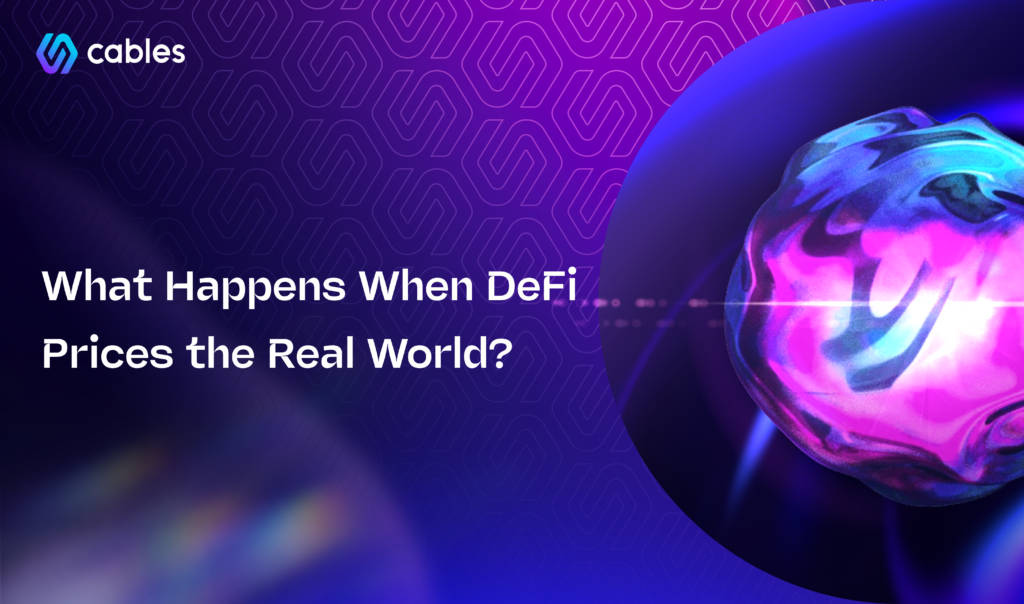Share this article:
What Happens When DeFi Prices the Real World?
In the 2020s began with DeFi mimicking Wall Street, 2025 marks the moment it starts absorbing it.
What happens when protocols on the blockchain don’t just trade synthetic crypto assets but begin to price, settle, and govern real-world value flows—like currencies, commodities, and sovereign debt?
The answer isn’t just “more liquidity.” It’s structural change. We’re not talking about financial engineering for insiders. We’re talking about redesigning market access, price formation, and economic agency from the ground up.
When Blockchains Become Price-Makers
For decades, pricing power has been consolidated—exchanges, banks, and opaque institutions mediate how assets are valued and who gets to participate. A farmer in Argentina doesn’t get real-time FX hedging. A retail trader in India doesn’t get direct access to short US Treasury exposure. Even in crypto, most assets are still pegged to the dollar and operate in a silo.
But now, DeFi protocols are starting to reflect and eventually influence real-world prices.
Tokenized gold is trading in real-time. FX pairs like EUR/JPY are beginning to appear in decentralized perpetuals markets. Real-world yield from US Treasuries, public credit, and commodities is being streamed onchain—composable, collateralizable, and programmable.
The moment DeFi begins to set rather than reflect prices for real-world assets is the moment the center of gravity shifts. From custodians to code. From institutions to incentives.
This Isn’t About Finance… It’s About Access
It’s easy to reduce “RWAs in DeFi” to just another narrative. But for billions of people outside the dollar-centric system, this movement carries real weight.
In places with unstable currencies or capital controls, onchain access to yield-bearing versions of the euro, yen, or gold offers a lifeline. Not just speculative upside—but sovereign alternatives. Not just “banking the unbanked,” but letting people opt into entirely new systems of value storage and exchange.
As DeFi protocols onboard more real-world assets, they’re not just offering exposure. They’re offering optionality. The ability to earn yield without a US bank account. To hedge FX risk without asking permission. To move value globally without relying on Swift.
The implications for remittances, savings, and even tax regimes are massive. We’re not just building apps. We’re redrawing the financial map.
The New Challenges of Governance and Credibility
But pricing the real world doesn’t come easy.
Protocols are now on the hook for more than just uptime. They must design governance systems that can responsibly manage assets tied to national economies. They must secure real-world data through oracle layers that are as much political infrastructure as they are technical middleware. They must prove trust—not just through smart contracts, but through community coordination and public transparency.
This is where most RWA projects today fall short. Either they sacrifice decentralization in the name of compliance, or they create walled gardens with little actual utility beyond speculation. Very few have managed to build infrastructure that is both composable and credible.
Cables Finance and the Next Frontier of DeFi 2.0
Cables Finance is one of the few projects aiming to tackle these complexities head-on.
Its upcoming launch brings together liquid staking for real-world assets (like cEUR, cJPY, and cXAU) with a full-stack perpetual futures DEX designed specifically for FX and commodities. This isn’t a fork of an existing crypto-native model—it’s a purpose-built exchange infrastructure designed to handle real-world volatility, multi-currency margining, and regulated asset flows.
And more importantly, it’s all tied together through a system the team calls the Cables Liquidity Flywheel—where users can deposit anything, earn yield on it, and then trade or leverage it in a unified system. Not separate silos of staking, swapping, and borrowing—but one self-reinforcing feedback loop that makes the system more efficient the more it’s used.
But perhaps what sets Cables apart isn’t the architecture. It’s the emphasis on community.
Not “users.” Not “wallets.” A community.
The idea is to move from passive speculation to active participation. Whether it’s deciding which assets come onto the platform next or how the system evolves, Cables is betting that the future of financial infrastructure isn’t just decentralized—it’s collectively governed, globally accessible, and economically aligned.
Final Thought
So—what happens when DeFi prices the real world?
Power shifts. Friction fades. And markets that were once gated, slow, or extractive become programmable, participatory, and permissionless.
It’s not just the next phase of DeFi. It might be the first real blueprint for a financial system that serves everyone—not just the privileged few.
We’re not there yet. But for the first time, the rails are being built. And they look a lot more like Cables than they do Wall Street.
Join the Cables community via X and Telegram to become a part of our greater vision and impact.
Share this article:


